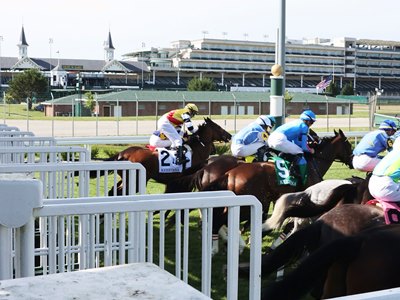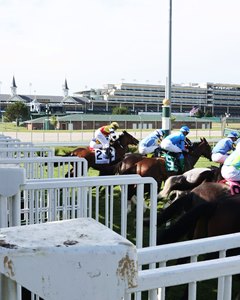On-Going Stride Study Focus of KHBPA Meeting


The details of an on-going stride analysis study that started at Churchill Downs and will continue during Churchill's spring dates being run at Ellis Park will be discussed with Kentucky horsemen and veterinarians during a meeting in Louisville, Ky., June 26.
Dr. David Lambert, CEO and co-creator of the StrideSAFE biometric stride analysis system, and Dr. Will Farmer, Churchill's equine medical director, will speak at the meeting being held 10:15 a.m. ET at Churchill Downs' Equine Medical Center in the quarantine complex across from the old backstretch stable gate. The meeting will be streamed live on the Kentucky Horsemen's Benevolent and Protective Association's YouTube channel.
Questions can be submitted in person, in the Youtube "live chat," as well as in advance by emailing kentuckyhbpa@gmail.com. The meeting is presented by the Kentucky HBPA and National HBPA in cooperation with Churchill Downs. National HBPA CEO Eric Hamelback will moderate the event.
Anyone attending the meeting should not expect to learn of any preliminary results from the on-going study, according to Farmer.
"We'll discuss the facts of how the study has been set up, what was approved, and what has not been approved," he said. "We have had a lot of inquiries and people want to use it so there is a lot of interest. Unfortunately, we are part of a detailed and constrained study."
Farmer acknowledged that Churchill has gone through a "unique set of circumstances from the end of April through May," that involved the catastrophic breakdown of 12 horses. These breakdowns have led to some changes to the study's initial design but nothing that warrants any preliminary release of results.
"You risk invalidating some of your research if you put out results before it has been verified or statistical analysis has been done. Our goal is to produce sound, scientific information that has been peer-reviewed and tested from an epidemiological and statistical standpoint," he said.
Lambert will discuss the StrideSAFE's sensor technology and address any concerns raised by trainers or veterinarians.
StrideSAFE is a biometric sensor mechanism placed in a horse's saddlecloth that can detect minute changes in a horse's gait at high speed with the hope of identifying at-risk runners before a catastrophic injury can occur. A grant from the Kentucky Horse Racing Commission allowed the study to be done at Churchill Downs and Ellis Park, which involves monitoring every horse in every race and a smaller group that is monitored during morning breezes.
The sensors create for each horse a biometric "fingerprint" that can be compared to an "ideal stride," which is a composite created from the analysis of 30 sound grade 1 and grade 2 winners.
In trials during morning works and racing done in cooperation with the New York Racing Association, Dr. Warwick Bayly and Lambert developed a system for flagging a horse's risk level. If a horse's stride was less than 1.9 standard deviations from the ideal stride, it was given a "green light," meaning the lowest risk for injury. A horse with a stride of 2-2.9 standard deviations from the ideal got an "amber light," and horses whose strides were three or more standard deviations from the ideal were flagged as "red light."
"It has been clearly established and published that 85% of catastrophic fractures have pre-existing pathology, so in other words, it has been there a long time," Lambert told BloodHorse June 22. "Something is going on and over a period of time it creates areas of weakness, which at some point finally gives way. The ones with the highest risk assessments are 300 times more likely to suffer a fracture than the ones who get the green light."
These areas of weakness in bone are typically the result of a horse not being able to rebuild quickly enough after the stresses of racing and training. Bone is a dynamic tissue that needs time to rebuild and strengthen following these periods of stress. If not enough time is allowed to rebuild, then certain areas remain relatively weak.
"To solve that problem, we need to get as far back as possible, identify the limb and the area—there is a small number of known places these fractures occur—and evaluate the area. If there is a problem, then rest the horse and let him remodel in a normal way. Then it is back to business. It is a biological problem, an individual problem, and it begins weeks before the fracture," Lambert said.
